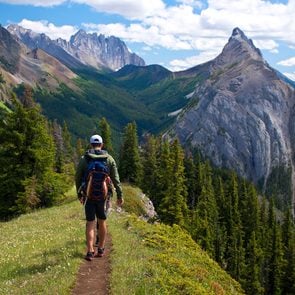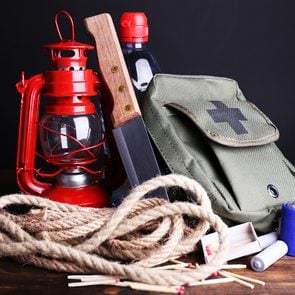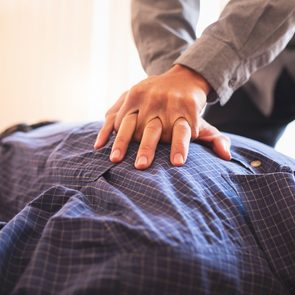These People Faced a Certain Death—and Lived to Tell the Tale
When faced with certain death, it takes bravery, determination—and plenty of luck. The stories of four people who lived to tell.
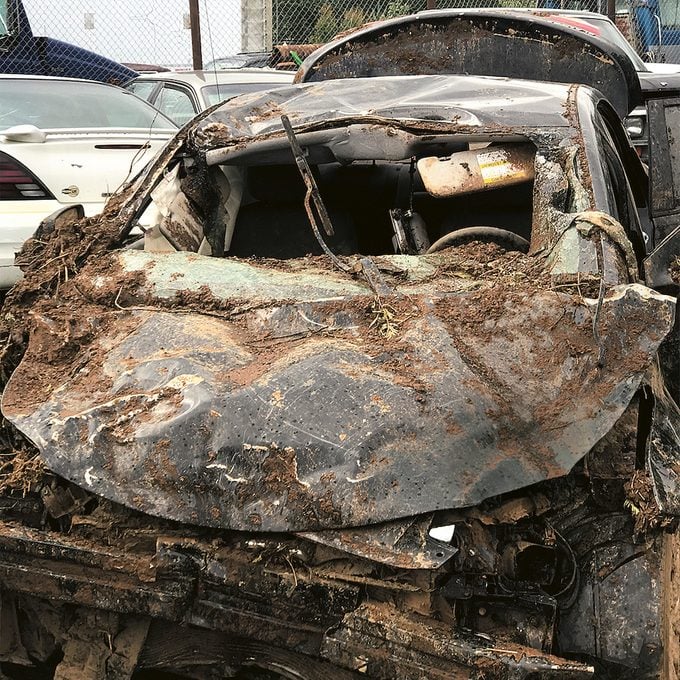
I Survived a Mudslide
Sheri Niemegeers, 47, an investment administrator
It was the Victoria Day long weekend in 2018 and my partner, Gabe Rosescu, and I were taking a road trip in his little Hyundai Elantra from my home in Weyburn, Saskatchewan, to visit friends in Nelson, B.C. We are both adventurous, and we couldn’t wait to go hiking and exploring. It was our first trip together, after six months of dating.
At around 5:30 p.m. on Thursday, May 17, we were driving about 18 kilometres west of Creston, B.C., on a steep mountain road known as the Crowsnest Highway. I was texting updates to my family and enjoying the view. We weren’t aware there’d recently been flooding in the area. When I looked up from my phone, I saw a wave of mud and an enormous tree barrelling down the mountain, right in front of the car. Gabe tried to brake, but it was too late.
I looked at Gabe and we both said, “Oh, shoot”—understatement of the century. The mudslide sent our car plummeting nearly 300 metres down a rocky cliff. It landed on its side in a group of trees.
I don’t know how long we were unconscious, but I woke up to the sound of Gabe moaning. He was slumped over the steering wheel, and there was blood everywhere. Outside my passenger window there was a steep drop. Every time I moved, I was hit with excruciating chest pain. I had broken my sternum, and my right ankle was smashed and practically turned backward. Gabe, meanwhile, had broken his orbital bone, nasal and cheek bones. Parts of his skull were crushed and his vision was damaged. But the body is an amazing thing, and somehow we were both able to crawl out of that wreckage.
I was so focused on our survival that I didn’t register the wrecked state of the car or where we were. We had no phone signal, so all we could think to do was yell for help. But my chest hurt too much to even breathe. So Gabe started shouting as loud as he could.
We were shocked when, after just a few minutes, we heard someone call back. Four bystanders had spotted us and waded through waist-deep mud to our rescue. I couldn’t walk, so the men took turns shimmying me up the rock face and helping Gabe make his way up to the road. Gabe was in shock, slipping in and out of consciousness, and I honestly didn’t think he was going to make it. When the EMTs finally got to us, they let us kiss goodbye from our stretchers as they loaded us into separate ambulances. I was swearing a lot as they took us away—I didn’t think I’d ever see my boyfriend again.
They took me to the closest hospital, in Trail, B.C., and Gabe was airlifted to the trauma hospital in Kelowna. All along the way, they kept shocking him to keep him awake. I was in the hospital for a week and a half, but they kept Gabe for six weeks. My surgeon had to reconnect the main artery in my foot, and Gabe’s had to split open his scalp three ways to reattach everything. Even after surgery, I’ll walk with a limp for the rest of my life, and Gabe permanently lost his vision in his left eye.
Before this all happened, we were happy-go-lucky people. We’re even more positive now. We look at everything differently. Even with the injuries we sustained, we’re grateful that we’re still living a pretty good life. The experience also bonded us as a couple. We even still go on road trips. A year after the accident, we drove back to the Crowsnest Highway and gave the finger to the mudslide. —As told to Emily Landau
We rounded up the 10 worst natural disasters in Canadian history.
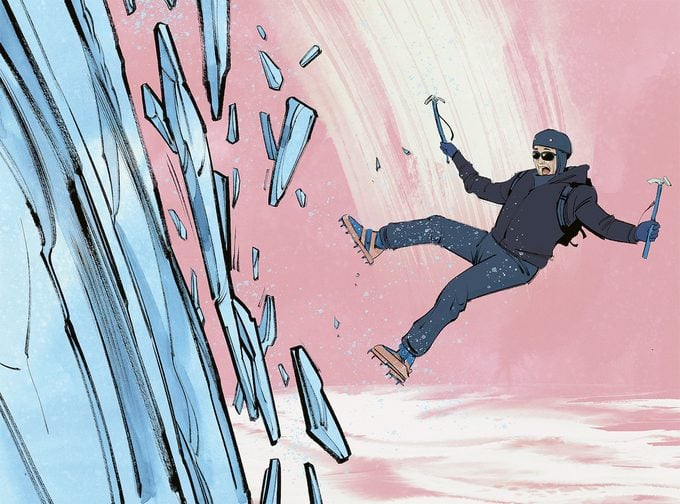
I Survived Falling Off a Mountain
Gurbaz Singh, 18, a student
When I was 13 I climbed my first mountain—a fairly gentle 1,200-metre peak near where I live in Surrey, B.C. I loved the challenge of conquering something bigger than myself. Soon I’d climbed nearly 100 peaks. My parents were happy that I found a hobby.
I often go climbing with my friend Mel Olsen, whom I met in a Facebook group. Three years ago, on December 30, the two of us drove to Oregon to tackle Mount Hood, a 3,400-metre stratovolcano.
It’s safer to start climbs at night, when there’s less risk of the sun melting the snowpack. We started our ascent at 3 a.m., following the paths alongside the ski runs. It was about -10 C, and we wore easily removed layers, knowing we didn’t want to get too hot on the climb. Along the way, we met two other climbers, and the four of us continued on together. After about five hours, we reached Devil’s Kitchen, a plateau at about 3,000 metres, just before the final push up the mountain. By this point, the wind conditions were nasty—it felt like my exposed skin was burning. The other climbers decided to turn back, but we went ahead. We had ice axes and crampons and helmets—we were prepared for the climb.
At around 9 a.m., we reached an ice step about a metre tall and sloping at around 75 degrees. I volunteered to go up ahead of Mel. You gain a sense of the ice when you stick your axe and crampons into it, and I thought it felt good. Then I suddenly heard a crack, and a whole slab of ice broke off the step, right under my foot.
First I fell backwards, and then I slid. I could hear Mel calling my name as I bounced off the rock face. I remember thinking, This is it. You’re done. But my fight-or-flight response kicked in, and I stretched out my arms and legs so I wouldn’t somersault down the mountain. After a few seconds, I landed back on a slope just above the plateau of Devil’s Kitchen. I’d fallen about 200 metres. My clothes were shredded, my helmet was broken, and I had cuts and scratches all over my face.
When I hit the ground, I was buzzing with adrenalin. I started thinking my way down my body to see where I was hurt, starting with my head, then my neck and my arms. My left femur had a spiral fracture right in the middle, and I could feel my bone slicing into my skin and muscle. When I reached my left leg, I couldn’t feel anything, so I tried wiggling my toes. That worked—at least I wasn’t paralyzed. As Mel made her way down, I started yelling for help, and a bunch of other climbers came to assist me. A couple of them were trained EMTs. They splinted my leg and called Portland Mountain Rescue. They took about two hours to get to where I was. Mel waited beside me while I tried not to scream from the pain.
The next challenge was getting me off the mountain. Eventually they loaded a sled into one of the ski run’s gondolas, but I was higher than the drop-off, so they dragged it the rest of the way. I’d been lying there for about four hours by that point. They strapped me into the sled and pulled me down the mountain.
When we got to the bottom of Mount Hood, I was loaded into an ambulance and taken straight to a hospital, where I stayed for four days. The doctors told me it would be a year before I could climb again, but I was back on the trails within six months. In May 2020, I climbed Mount Crickmer, in the Fraser Valley. It was only about 20 kilometres, and a gentle elevation, but it felt amazing to be out there again. I’ve climbed another 60 mountains since the accident. I’m not going to let one fall—no matter how terrifying—keep me from doing my favourite thing in the world. —As told to Emily Landau
This man was stung a thousand times by killer bees—and survived.
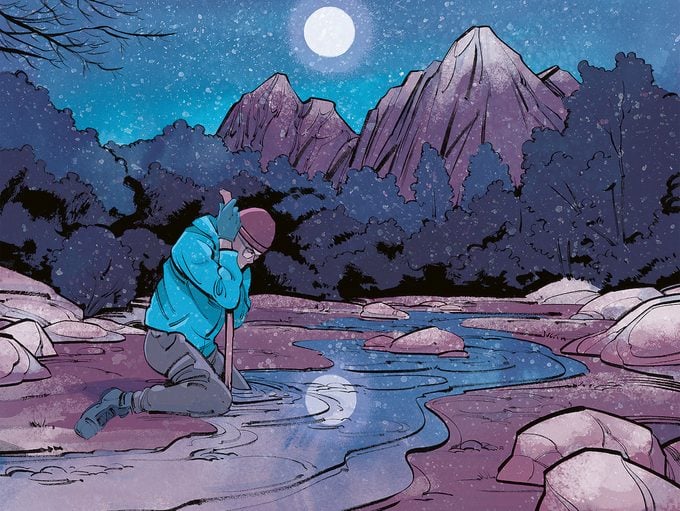
I Survived Quicksand
Ryan Osmun, 34, a photographer
The Subway is a trail in Utah’s Zion National Park that’s named for its spectacular tunnel-shaped canyon. On Valentine’s Day 2019, Ryan Osmun and his girlfriend, Jessika McNeill, both from Mesa, Arizona, had the trail to themselves. The National Park Service describes the hike as “very strenuous,” requiring “route finding, creek crossing and scrambling over boulders.” Nowhere does it mention quicksand.
It was sunny when we set out from the trailhead at 8 a.m. Halfway through our 16-kilometre hike, after we’d climbed boulders and forded streams, a light snow began to fall. Soon after, we entered the Subway and its swirling, rust-coloured walls. Standing in our way was a small pond. The trail continued on the other side, and, because it looked shallow, we began to wade through, with Jessika leading the way.
About 1.5 metres from the edge, her front foot sank into the sandy bottom. Then she fell forward, and both legs started to sink. I lunged, grabbed her under the shoulders and pulled her out of the muck. She then scrambled back to shore. But now I was sinking. The muck came all the way up to my right thigh and my left calf. I freed my left leg but I couldn’t move my right leg at all. Jess handed me a long stick we’d picked up earlier in the hike and I jammed it down the side of my leg and tried to wiggle and pull my leg out. Nothing.
Jessika started scooping sand with both hands, but it was refilling faster than she could pull it out. I told her to stop; she was wasting her energy. I was not getting out of the quicksand.
The only cell reception was back at the trailhead, five hours away over rough terrain. I told Jessika she had to hike back and call for help. She was scared—she’d only ever hiked with me and was wary of hiking alone on such a difficult trail. But we were out of options.
Thirty minutes after she left, it started to snow heavily. I zipped up my jacket and pulled my head inside. At some point I nodded off to sleep. I don’t know how long I was out, but I woke up falling backward into the pond and the quicksand. I urgently planted my stick into the dry ground and pulled myself up. I was exhausted. If I fell back again, I’d never be able to get out. It had been about five hours since Jess left, and it was getting dark.
A few hours later, I saw a light through my jacket. I prayed it was a helicopter, but it was just the moonlight shining over the canyon walls. At that point, I was soaking wet and knew I wasn’t going to make it. I started to think about what I could do to die faster. But I didn’t want to drown if I fell again. That would be the worst way to go.
An hour later, another light shone across my eyes. A flashlight! I yelled for help. A man hollered back as he ran to me. His name was Tim, and he said that Jessika had gotten through to rescuers. He had hiked up, and the rest of his crew was an hour behind.
When the three others arrived, they set up a pulley system to yank me out. Two of the rescuers held me under each shoulder as Tim wrapped a strap around my kneecap. An anchor strap was tied around a boulder. A fourth rescuer worked the pulley. With each ratchet, it felt like my leg was being ripped off. Tim dug into the sand and got a hand around my ankle and started pulling up. It was agonizing, but I could feel my leg moving. “Keep going!” I screamed.
Three more ratchets and my leg was freed. My rescuers dragged me to the side of the canyon because I couldn’t walk. I couldn’t feel my leg at all.
It was too dark and snowy for a helicopter, so they got me into a sleeping bag, gave me pain medication, and we settled in for the night When I woke up at 6:00 the next morning, snow covered the top of my sleeping bag, and it was still coming down. Around noon, the weather lifted, and they called in a helicopter.
My leg had swollen to the size of my thigh, but when I got to the hospital in St. George, X-rays revealed no fractures or breaks. I had sat in the quicksand for 12 hours and thought for sure I would die. But I didn’t. —© 2020, by Jason Daley. From Outside (March 6, 2020), outsideonline.com
When a speeding boat severed his arm, this diver fought to survive.
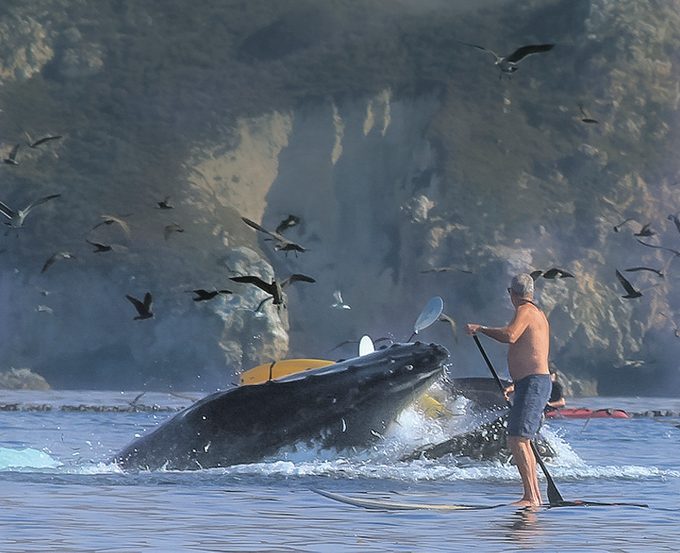
I Survived Getting Swallowed by a Whale
Julie McSorley, 56, a physical therapist
I live with my husband, Tyrone, in San Luis Obispo, California, about six kilometres from the beach. Every few years, the humpback whales come into the bay for a few days while they’re migrating. Last November, the whales were around, so we took out our yellow double kayak to watch the wildlife. We paddled out the length of the pier and saw a whole slew of seals, dolphins and about 20 whales feeding on silverfish. It was incredible. They breached and sprayed through their blowholes, and were just so graceful and majestic. Each one is huge, about 15 metres long, and sometimes they turned their side fins so it looked like they were waving at us. That was really cute.
At the time, my friend Liz Cottriel was staying with us. We met 28 years ago, when she worked as a receptionist for my dad’s dental office. The morning after Tyrone and I saw the whales, I asked Liz if she wanted to go out on the water to see them. It had been such a magnificent experience, and I wanted to share it with her.
“No way,” she said. She’s scared of whales and sharks and was terrified the kayak would overturn while we were in it. I told her there was nothing to worry about, promising that the craft was super stable and that we could turn back any time. After some cajoling, I finally got her to agree to join me.
We got out on the water at about 8:30 the next morning, and there were already about 15 other kayakers and paddleboarders in the bay. It was warm for November, about 18 C, so we wore T-shirts and leggings. For the first half-hour or so, we didn’t see anything. Then I noticed two pairs of whales right past the pier, swimming toward us. We were in total awe: it’s an amazing feeling to be that close to a creature that size.
When whales go down after breaching, they leave what looks like an oil slick on the water. I figured if we paddled toward that spot, we’d be safe from the whales, since they’d just left. We followed them at a distance—or what I thought was a distance. I later found out that it’s recommended to keep 90 metres away, or about the length of a football field. We were probably more like 18 metres away.
All of a sudden, a tightly packed swarm of fish, known as a bait ball, started jumping out of the water into our kayak. Their movement sounded like crackling glass all around us. At that moment, I knew we were too close. I was terrified. Then I felt the kayak lift out of the water—just about two metres, we later learned—and tip back into the ocean. I figured the whale was going to drag us down, and I had no idea how deep we’d be sucked underwater.
What I didn’t realize at the time was that Liz and I were in the whale’s mouth. It had engulfed my entire body except for my right arm and paddle. Liz, meanwhile, was looking up directly into the whale’s jaw—it was like a big white wall. She told me later that she thought she was going to die. I was worried about being sucked down by the vacuum, so I just kept thinking, “I’ve got to get up. I’ve got to fight this. I’ve got to breathe.”
Whales have enormous mouths but tiny throats. Anything they can’t swallow, they spit right out. We were wearing life jackets, and soon we both popped up out of the water about a metre apart. The entire ordeal lasted only 10 seconds long, but to me it felt like an eternity.
A few people were nearby, and someone shot a video of the entire incident. Three or four people paddled over, including a retired firefighter who asked us if we were okay, and if we had all of our limbs. “You were in the whale’s mouth!” he told us. “We thought you were dead.” A few days later, I studied the videos and saw how close I’d come to being injured or killed. I became so much more appreciative of life after that day.
There’s no way I’m going to get that close to the whales again. I want to respect their space. I’m so much more aware of the power of nature and the ocean. And I believe that I would have died if it was my time to die. Lucky for me, it wasn’t. That afternoon, when we got back to shore, Liz removed her T-shirt to dry it off—and five or six fish flopped out. —As told to Emily Landau
Next, check out our collection of Reader’s Digest‘s most gripping survival stories.
